Yellow tea, one of the rarest and most refined Chinese teas, offers a unique flavor profile and a fascinating history. Let’s delve into the elegance of yellow tea.
Yellow tea dates back to the Tang Dynasty and was once a tribute tea enjoyed by emperors. Known for its distinctive yellow leaves and liquor, this tea undergoes a meticulous processing method that gives it its characteristic flavor and aroma. Its unique yellowing process distinguishes it from other teas and contributes to its smooth, mellow flavor.
Yellow tea is a lightly fermented tea known for its mellow and sweet flavor. Unlike green tea, which is quickly dried after being pan-fried, yellow tea goes through a slow and controlled fermentation process called “sealed yellowing” or “menhuang,” which allows the tea leaves to turn a yellowish color and develop a distinctive aroma and taste.
Yellow tea is primarily produced in Hunan, Hubei, Sichuan, Anhui, Zhejiang, and Guangdong.
Processing Technique
The production of yellow tea involves several key steps:
Withering: Fresh tea leaves are spread out to wither and lose some of their moisture.
Pan-firing: The leaves are pan-fired to halt oxidation, similar to green tea.
Sealed Yellowing (Menhuang): This crucial step differentiates yellow tea from green tea. The leaves are wrapped in a damp cloth or paper and allowed to oxidize slowly. This process can take from a few hours to several days, depending on the type of yellow tea.
Drying: The leaves are dried to remove remaining moisture and to lock in the flavor developed during the yellowing process.
This process results in tea that has a yellow hue, both in the leaves and the liquor, with a more mellow and less vegetal flavor compared to green tea.
Varieties
Yellow tea can be categorized into three main types based on the size and tenderness of the leaves:
Yellow Bud Tea (Huang Ya Cha): Made from young buds, examples include Junshan Yinzhen from Hunan province.
Yellow Small Leaf Tea (Huang Xiao Cha): Made from slightly larger leaves and includes teas like Beigang Maojian and Weishan Maojian.
Yellow Large Leaf Tea (Huang Da Cha): Made from mature leaves, such as Huoshan Huangya and Guangdong Dayeqing.
Some of the most renowned yellow teas include:
Junshan Yinzhen: Known for its needle-like shape and subtle sweet flavor, this tea is a top-grade yellow tea from Hunan.
Huoshan Huangya: A popular yellow tea from Anhui province, characterized by its yellow buds and rich, mellow taste.
Mengding Huangya: From Sichuan province, this tea has a history dating back over a thousand years and offers a delicate, slightly sweet flavor.
Brewing Method
Yellow tea is best brewed at a slightly lower temperature. Use 3-5 grams of tea per 150ml of water at temperature 80-85°C and steep for 2-3 minutes. Yellow tea can generally be re-steeped multiple times.
Yellow tea offers a delicate balance of flavors that is both refreshing and soothing. Its unique processing method and distinct characteristics make it a tea worth exploring for any tea enthusiast.
Enjoy the mellow sweetness and rich history that comes with every sip of yellow tea!


